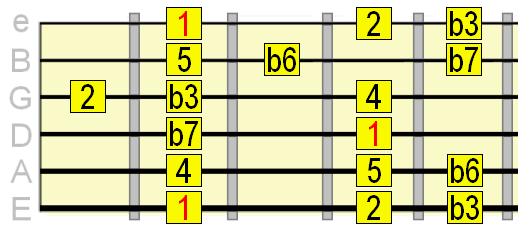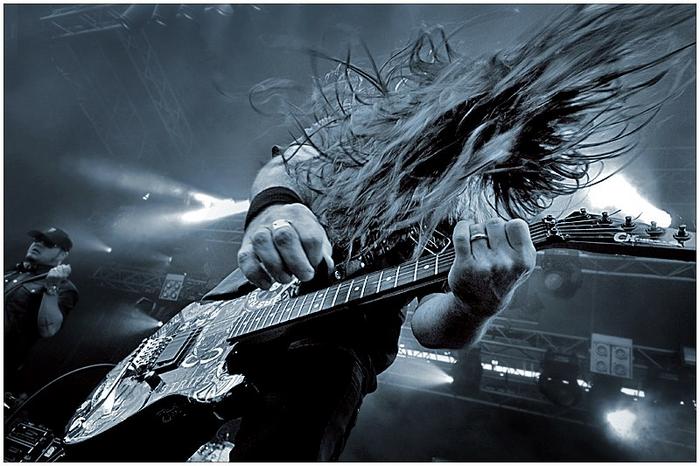Imagine this: I’m 17, completely mesmerized by the stunning, frenetic playing of some of the best metal guitarists in the world. I pick up my guitar, determined to mimic the rapid-fire solos that I’ve come to idolize. In that moment, my journey towards mastering metal guitar scales began. Little did I know, a world of phenomenal complexity and beauty lay simple beneath these strings. A world that would shape me not just as a musician, but as a person, too.
You see, unlike other guitar scales, metal ones can take you on an intense ride, with their often rapid, chromatic structures and, at times, exotic tonalities. They’re not just notes; they’re a visceral language that iconic metal guitarists have conquered to create searing licks, unforgettable riffs, and, most importantly, signature styles.
As a long-time guitar enthusiast and professional, the endless variety and depth of metal guitar scales have kept me engrossed and challenged for years. This article shares my insights and findings from countless guitar lessons, practice sessions, and performances, as well as tips to help you start shredding just like our metal legends. So, strap on your guitar, and let’s dive in.
Exploring Essential Metal Guitar Scales
Understanding Scale Formation

My deep-dive into the world of complex sonic textures during my master’s degree in Contemporary Improvisation underscored the undeniable truth that understanding scale formation is crucial in mastering metal guitar scales. The process broadened my understanding of music theory for guitar in essential ways. With this knowledge, I promise to simplify this seemingly complex area of study into digestible bites.
At the heart of scale formations lie scale intervals; the building blocks of scales. You can imagine a scale as a series of steps moving up or down, with each step defined by an interval. Crucially, scales in metal are typically formed by combining different intervals. For example, a Mixolydian scale, a staple in metal, keeps the listener on edge by adding a minor seventh interval to a major scale.
Some scales get their distinctive sounds from shifting the notes usually found at these intervals. The Harmonic Minor scale, another essential for metal guitarists, achieves its dramatic sound by raising the seventh note of a Natural Minor scale. Clearly, understanding scale intervals is vitally important in contributing to the unique tonal qualities of metal.
Here lies the real-world application of music theory for guitar. It’s not just about understanding the rules, but knowing how to break them for desired creative outcomes. And in the world of metal guitar, creative rule-breaking is the norm!
So, keep pushing boundaries, using the understanding of scale intervals and how they form different scales as your Homeric epic through the diverse terrain of the metal guitar landscape. Remember, the adventure of this journey is in the mastery of the scales – all the way from scale formations to ripping solos!
Applying Guitar Scale Tablature and Diagrams

Transitioning from the intricacies of scale formation, let’s dive into the robust world of guitar scale tablature and diagrams. Simplified, these notations are the roadmap for your fingers, guiding you to produce the metallic symphony you’re chasing.
It’s crucial to not perceive them as overly complicated patterns. Instead, as a transcriber and engraver, I spent countless hours devising and understanding scale diagrams and tablatures. I found the beauty lies in their degree of adaptation and their ability to unlock powerful licks and riffs.
Breaking it down, guitar scale tablature is a form of musical notation for guitar. Each line represents a string on the instrument, and the numerical notations depict the fret to be used. Crossing the initial apprehension often associated with these notations can truly define the difference between casual strumming and sculpting a compelling tune.
Complementing the tablature are guitar scale diagrams. They provide a more visual representation of scales, presenting a bird’s eye view of your fretboard with markers indicating where your fingers should land. As you forge your path in metal guitar, these diagrams serve as an essential tool in digesting and understanding scales, enabling you to transform mere notes into melodic marvels.
To master these two aspects is to bridge the gap between understanding scales and producing music. The juxtaposition of tablature and diagrams allows for a comprehensive look into the world of scales and the infinite possibilities they present. It teases the fingerboard of your guitar, turning it into your playground to experiment, create, and perform.
Armed with this knowledge, you’d be one step closer to shredding like the legends. As we move forward, we’ll listen to audio examples, aligning our theoretical comprehension with practical execution.
Listening to Guitar Scale Audio Examples

In my quest to master the art of metallic scale shredding, spending time with guitar scale audio examples featured significantly. During both my tenures at Premier Guitar and Acoustic Guitar, first-hand experiences with a vast array of such audios added a potent dimension to my journey. Listening, reviewing, analyzing – I did it all, and I would love to share some of those significant audio examples with you.
These guitar scale audios effectively breathed life into those tablatures and diagrams we’ve gone through earlier. You imagine and visualize when you look at those images or read those strings of notes, but your imagination takes flight when you listen. You grasp the finer details, appreciate the nuances, and the scales transition from knowledge to something instilled. It’s here that the guitar scales emerge from theory and truly begin to resonate with metal’s raw power.
As we proceed in our exploration, remember that these audio examples are not just sonic references. They are narrative markers on your path to shredding glory, each with its story and contribution. Next up, we delve into applying these drawn and heard scales into powerful metallic technique.
Applying Metal Guitar Techniques

Fondly recalling my history with guitar playing, I remember countless afternoons spent grappling with the nuances of metal techniques, each one promising new depths to my performance. Whether it was unusual drop tuning methods or advanced shred guitar skills, I found myself drawn to their complexity and dynamism. Through years of my hands dancing over the fretboard, practicing guitar fingering patterns, I eventually mastered these coveted techniques. Now, it fills me with joy to pass on this hard-earned knowledge to you.
Did you know certain playing techniques can change how a guitar scale sounds? Prepare to learn some metal style secrets. Understanding these techniques opens up a world of creative possibilities, transforming an ordinary chord progression into something truly awe-inspiring. I learned this firsthand after relentlessly experimenting with different modal scales and encasing my playing in the rich, textured soundscapes they offered.
Drop tuning is one such technique that has considerably shaped my playing style. By reducing the pitch of a string, it allows for heavier chord voicings and provides a distinct edge to your music. It played a key role in my progress with metal guitar, adding that quintessential ‘heavy’ feel. Plus, it made playing power chords effortlessly easy.
Perfecting my shred guitar skills felt akin to an uphill battle. But as I practiced the rapid-fire sequences, string skipping, and speedy alternate picking, I felt an exhilarating rush. Now, I can attest that few things beat the thrill of executing a flawless, lightning-fast guitar run.
Developing my understanding of modal scales proved to be a turning point. They added fresh color to my compositions and allowed for expressing varied emotions. Bringing these scales to life while jamming opened up unique harmonic contexts, enabling me to construct solos and riffs infused with surprising and intriguing tonal elements.
One essential facet I always emphasize is a scale length guitar setup. Understanding the significance of different scale lengths helped me realize the potential for varied tones and pitches. Once I rebalanced my guitar setup accordingly, my performances reached a new level of refinement. Navigating the fretboard became more user-friendly, and my fingers transitioned between notes more smoothly.
An interesting revelation was understanding the dynamics of guitar fingering patterns. Learning how to effectively maneuver my fingers across the fretboard served as a lifeline in my quest to nail difficult techniques. By practicing different patterns, my fingers learned to dance across the frets effortlessly, opening doors to yet unimagined musical destinations.
Throughout my journey with metal guitar, each technique I gathered has enriched my skills manifold. By earnestly applying these specialized tools, I’ve transformed my practice sessions into a thrilling exploration of sounds and textures.
As we move forward to the next section of our roadmap – ‘Developing and Playing Metal Riffs and Solos,’ remember the techniques we’ve just covered. They will play a pivotal role in constructing those infectious metal riffs and mind-blowing solos that will make you the shredder of your dreams.
Developing and Playing Metal Riffs and Solos
Exploring Styles of Renowned Metal Guitarists

Having spent countless hours analyzing and admiring the work of renowned metal guitarists, I’ve noticed aspects of each style that have helped to define the genre and inspire countless musicians. These explorations are crucial to developing and playing our riffs and solos, helping us not merely to mimic, but forge our path using the toolkit of these masters.
An examination of ’80s metal guitar scales reveals many of the favorites, and frequently revisited techniques today’s metal guitarists continue to use. These classic metal scales established the bedrock for speed, precision, and audacious tech-savviness that characterize metal solos and riffs.
A key example of this style is seen in Black Sabbath’s Tony Iommi, the architect of heavy metal’s sonic template. His power chords and tritone intervals made black metal scales famous. From these foundations, black metal became a genre that embraced the unconventional, pushing against the boundaries of traditional metal scales.
Exploring styles of revered metal guitarists, we find a richness of skills and approaches that inform our understanding of the genre’s evolution. The shredding speed of Yngwie Malmsteen, the heavy palm-muted riffs of Slayer’s Kerry King, or the fusion of classical and metal scales by Randy Rhoads, all illustrate the diverse approaches to metal guitar playing.
These styles, distinct but interrelated, demonstrate how different interpretations of metal scales contribute to the genre. By incorporating these elements into our skills, we can further broaden our stringed vocabulary, enhancing our ability to express ourselves in solos and riffs while paying homage to these legends.
Understanding how these metal maestros used scales and techniques affords us the tools to develop our sound. It’s a fascinating and rewarding journey that instills deep respect for the genre’s roots and inspires us to push its boundaries further. As we continue to delve into standard and exotic guitar scales, we keep the influences of these renowned metal guitarists in mind, cultivating our unique sound.
Comparing Standard and Exotic Guitar Scales

To truly master shredding on your metal guitar, a deep understanding of both standard and exotic guitar scales is essential. In my book, ‘Color Your Chords’, I delve into a range of scales and how they lend themselves to defining one’s personal style.
Standard scales tend to be the foundation of most metal riffs and solos. Pentatonic and blues scales are commonplace, offering a gritty and aggressive sound. Mindful fingering, strategic sliding and bending, alongside well-placed vibratos, can create a fiercely expressive performance.
However, exotic guitar scales open up a spectrum of unique tonal possibilities that can add a distinct flavour to your metal sound. Take the Hungarian minor scale for instance; its enigmatic and somewhat eerie vibe can give your solos a distinctive edge. Similarly, the Hirajoshi scale, originating from traditional Japanese music, transforms standard riffs into moodier and more atmospheric soundscapes.
By comparing standard and exotic scales, we realize the endless pool of inspiration they offer. Exotic scales push the creative boundaries, bringing flavors from across the globe to metal music and adding depth to your riffs and solos. Ultimately, the right blend of standard and exotic scales can help you develop a style that resonates with your musical identity.
As we progress and explore the styles of renowned metal guitarists, keep in mind the diversity of scales they draw from. Whether it’s the use of a standard scale with masterful phrasing or an exotic scale delicately woven into a ferocious solo. They are all artists who have mastered the art of communicating emotions through their strings!
FAQs
What are the basic scales for metal guitar?
The basic scales used in metal guitar are the Minor Pentatonic scale, the Natural Minor scale (also known as the Aeolian mode), and the Harmonic Minor scale. Each scale creates a different sound and mood, used extensively in metal music for solos, riffs and song-writing.
How does practicing scales improve my metal guitar skills?
Practicing scales improve your finger dexterity, coordination, and strength, which are crucial for executing fast and intricate metal riffs and solos. Furthermore, understanding scales can assist in creating melodies and harmonies, ultimately improving your improvisation and songwriting skills.
Are there any specific techniques for playing metal guitar scales?
Yes, there are specific techniques for playing metal guitar scales. These include alternate picking, sweep picking, tapping, and string skipping. Control over these techniques allows metal guitarists to play at high speeds and incorporate complex melodic patterns into their playing.
Conclusion
In sharing my wisdom and passion for metal guitar through this guide, I hope to have laid a solid groundwork towards helping you become an accomplished shredder. True proficiency is only reaped from a foundation of knowledge, guided purposefully by skillful techniques and sustained practice. By exploring essential metal guitar scales, understanding their formation, and applying scale tablature and diagrams, I believe you’re on the path to musical mastery.
Listening to audio examples, developing your distinct metal riffs and solos, and taking a leaf from renowned metal guitarists’ styles, amplifies your grasp of the fretboard. As your hands navigate its length, know that every metal icon once was a novice, and it’s through persistent dedication that they made their mark. Your understanding of both standard and exotic guitar scales, coupled with your creativity, could be the start of your signature sound.
In essence, with the proper tools – this guide in hand – and the right mindset, along with unfailing commitment to practice, you are one step closer to shredding like a legend. Imagine reaching your guitar goals and more. It all begins here. Happy shredding!
